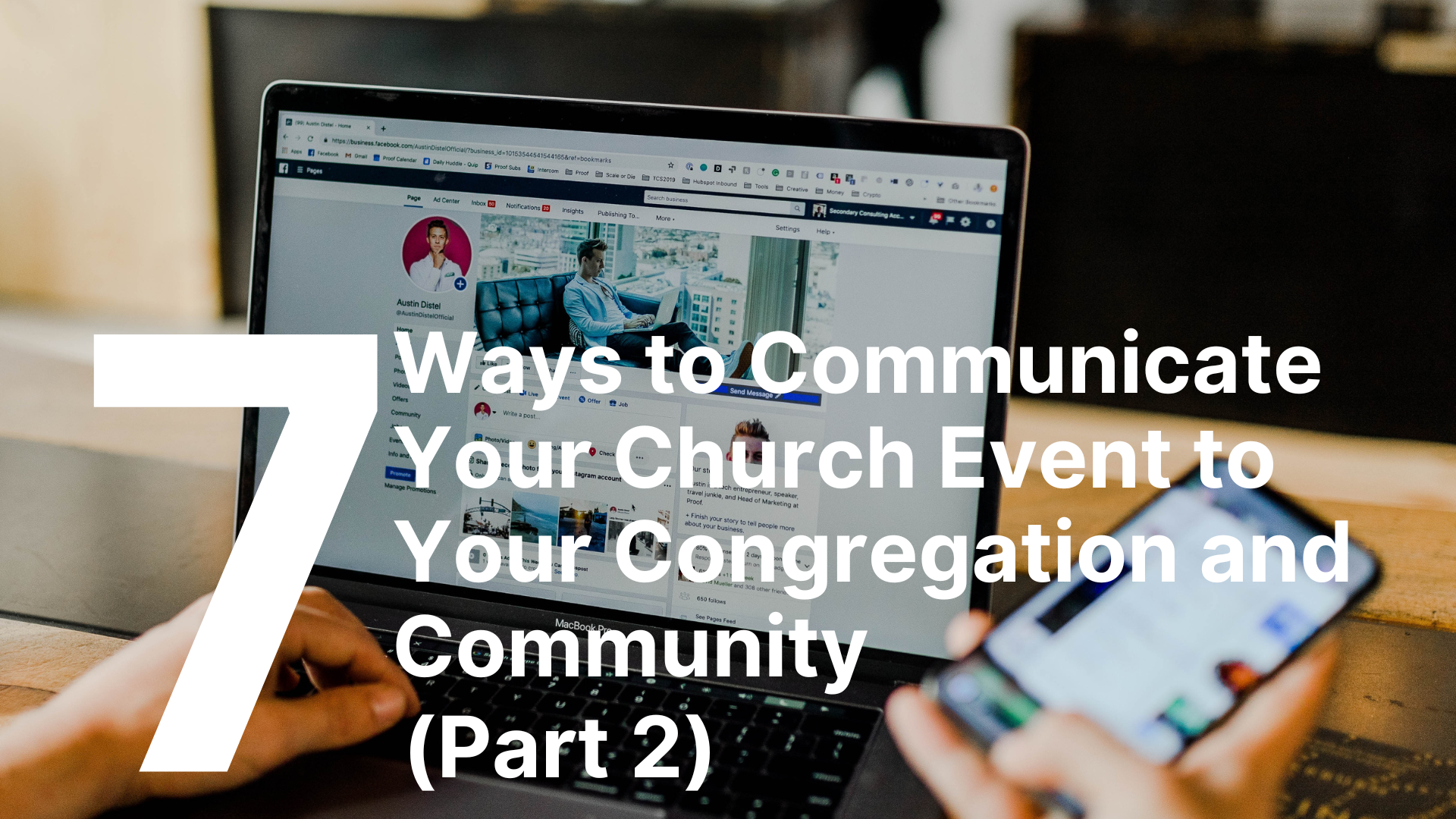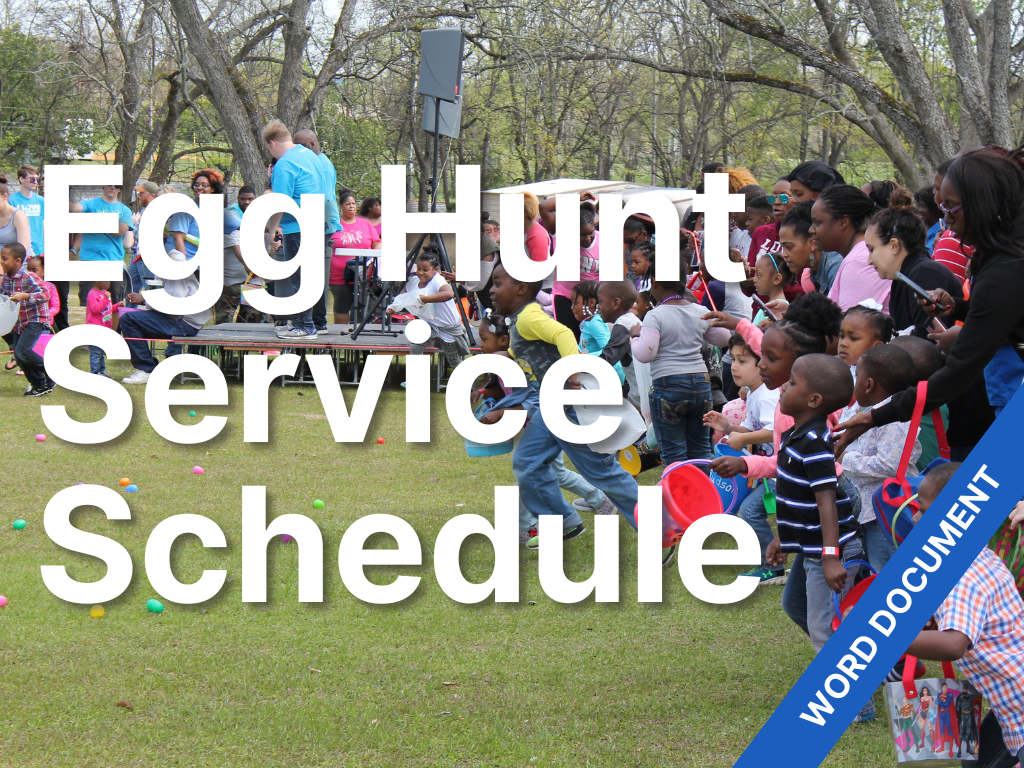7 Ways to Communicate Your Church Event to Your Congregation and Community (Part 2)
Photo by Austin Distel on Unsplash
You’ve got big news. You’ve been working on this project for weeks and its finally time to make your big debut. You have all the supplies and resources. You’ve prayed and feel that God is with you. Now it’s time to announce to the church and your community what you’re doing and how they can get involved. But how do you do that? What’s the best way to get the word out? What’s the silver bullet that gets everyone to buy in and get excited for what’s coming?
The truth is there isn’t one. Communication, marketing, advertising, whatever you want to call it isn’t a one and done thing. You have to repeat your message over and over in as many places and mediums as possible. Big companies know this. How many commercials can you quote? How many logos can you identify just by the color scheme? How much can Geico save you on car insurance? You know because they put it in front of you in as many ways and as often as they can afford.
Just because we’re in the church world, doesn’t mean we’re any different. We have a smaller audience, so we don’t have to spend millions, but we do have to spend something.
Over the years I’ve identified 7 channels of communication that gets your word out to your people and your community. It takes time, money, and talent to do it well, but if you want your message to get out, you’ll need to use as many of these channels as possible.
In the first part of this series, I focused on the channels that people interact with when they come to your church, i.e. stage announcements, bulletin, banners, and booths. You can read all about that here. In this part, I’ll talk about getting the message out of your church and into your community.
1. Website
Your website may be your most valuable tool for getting the message out of your congregation and into your community. More than social media, you control the look, feel, and messaging. You don’t have a company coming to change things on you overnight like what happens on Social Media. (Looking at you Facebook!)
Your website should be the central hub for your message whether it’s an event or what you’re teaching on Sunday. We live in an on-demand culture and people want to get the information when they’re ready for it. No one wants to send an email, text, or (gasp) call someone to find out more.
For every event, I create a landing page with all the pertinent information answering the 5 W’s. What are we doing? Who is this for? Where are we doing it? When? Why? How can I get involved?
I know that’s 6, but “how” has always been the oddball with its w at the end.
While you could answer all these questions in a bulleted format, no one wants to read that. You can see many great landing pages for Trunk or Treats here, here, and here.
You may be tempted to create a separate webpage for your ministry or event. I caution against this. Similar to having a house of brands over a branded house, you’ll be on your own starting from scratch trying to get traffic to your site. It’s far easier to house your information on the main church website. Then a lot of design decisions are made for you, and you benefit from the traffic from the existing site.
I have experimented with creating a single landing page site for a big event like Easter or Christmas using christmasatmycity.com. Since I pay for ads on Google and Social Media this works well, but it still connects to the main church site.
One change I made years ago was to create a single event page for every event in the church. Instead of my church people having to remember the exact website for each event, this page is a central hub with basic information and links to the respective landing pages. This way you and your people don’t have to remember your web address like yourchurch.com/light-the-night-2023 or yourchurch.com/ltn. The first is cumbersome to type and the second only makes sense to insiders.
Send people to yourchurch.com/events for everything and they can get the information they need. (The sites I used for landing pages all use this strategy.)
2. Social Media
While the website may be your greatest tool to get your message out in the community, its main limitation is that people have to go to your site to get the information they’re looking for. Using social media goes where the people are. When I asked for examples for landing pages from the Kidmin community (thanks to those who responded!) Almost all of them sent me a Facebook event. Most people in your church and in your community use some form of social media. You need to be there too.
When churches first started to use social media, me included, we used it like a megaphone. It was like stage announcements and the bulletin all in one. However, after a while we realized our messaging self-centered. Every post was all about us and not about the people we’re called to serve.
Social media is designed to connect with others and (increasingly more) to entertain. While we can and should use social media to get our message out, we have to do it in a way that connects people to each other and/or entertains. That’s easier said than done and takes creativity and planning. This is why more churches are hiring communications specialists just to manage their social channels.
But most of us don’t have that kind of budget or time or creativity, myself included. That’s why I created and still use this social media plan to connect with my parents and advertise my events.
There is a huge rise in short-form vertical videos right now and will probably continue for the next year or two. Creating these videos is simple and can be done in as little as 10 minutes a day. I’ve been creating them for the past 10 months and have seen my audience dramatically increase month over month. You can see them here.
3. Email
Email may be my favorite form of communication with my audience and the community. When I was a kids’ pastor, I would send out an email every week to my parents and another one to the whole church talking about what was going on in each area.
These used to take me hours to make. They were elaborate with pictures, graphics, and multiple announcements. I’ve since pared them way down to just one thing. You can read my strategy for writing emails that are read and clicked on here. If you subscribe to my blog, you can see it in action every week.
For every event I do, I collect people’s email addresses. I then add them to an event email list which I use the next time I’m ready to announce an event. There was one time I opened VBS registration and after two weeks only had 10 registered despite stage announcements, banners, flyers, social media posts, and a booth in the lobby. I was complaining to one of my leaders about it, and she said she was waiting for an email to register her four kids. I sent the email later that day and by the end of the week, I had over 100 registrations.
Email is the ultimate social media. When people share their email with you they have given you permission to email them. Email them regularly with relevant, helpful information, and they’ll open and read your emails for years to come.
4. Text
Mass texting is a relatively new channel for me and one that I rarely subscribe to myself. However, 97% of all text messages are read, making it the most effective tool for getting the message out.
Most of the time these messages are limited to 140 characters including your link and don’t have media associated with it. Typically, I’ll consistently send one to two messages a week. The first one talks about our Sunday focus and the second for an event or connection opportunity. Both of them have a link to more information on my website.
There are a lot of great texting companies out there and most of them charge. The one I like the most is Remind. It’s made for schools but can be easily used for churches. It has a free option that allows you to have up to 5 audiences. The paid version opens up a lot more options if you want it to be comprehensive for the whole church.
When I first started using texting, no one signed up for it despite using all the channels I mentioned before. After asking around, I was advised to add my parents to the texting audience and then ask for their permission to text them. Following their advice, I had close to 80% of my parents on the texting list and only a few opted out.
Don’t be afraid to add people to a contact list, Facebook group, or email list. Just make sure that when you do, you give them make it easy for them to opt out in your first message. Whatever you use, don’t annoy your audience by sending too many messages or at weird times. They’ll unsubscribe in a second.
You can have the greatest event planned ever, but if no one knows about it you’re sure to fail. You have to use as many methods of communication as possible to get your message out to your church and your community.
Using the seven I’ve outlined in this series will help make sure that everyone who wants to get the information will get the information. You’ll find your events well-staffed, well-attended, and successful because your message was heard.




This kit gives you a kids registration card, check-in procedures, and a guest letter for parents. All of the documents use word except the registration card, which uses Photoshop.